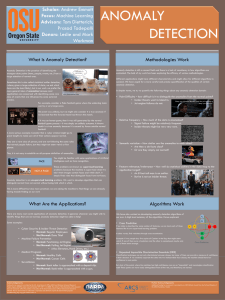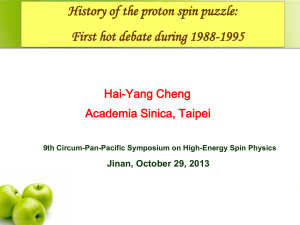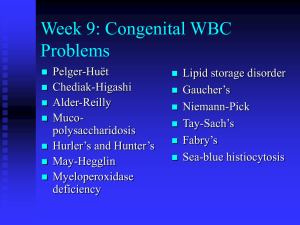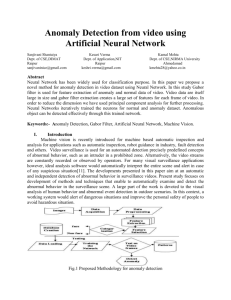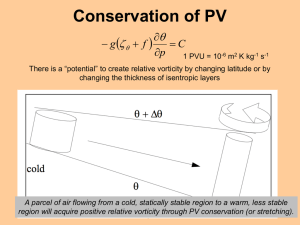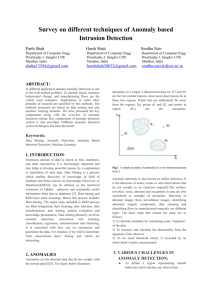here
advertisement
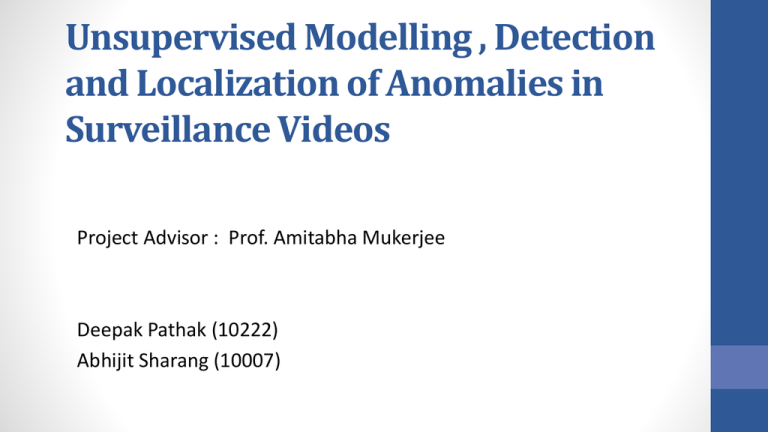
Unsupervised Modelling , Detection and Localization of Anomalies in Surveillance Videos Project Advisor : Prof. Amitabha Mukerjee Deepak Pathak (10222) Abhijit Sharang (10007) What is an “Anomaly” ? • Anomaly refers to the unusual (or rare event) occurring in the video • Definition is ambiguous and depends on context Idea : • Learn the “usual” events in the video and use the information to tag the rare events. Modelling • Unsupervised Modelling Detection • Anomalous Clip Detection Localization • SpatioTemporal Anomaly Localization Step 1 : Unsupervised Modelling • Model the “usual” behaviour of scene using parametric bayesian modelling. • Topic Models : Leveraged from Natural Language Processing • Given: Document and Vocabulary • Document is histogram over vocabulary • Goal: Identify topics in a given set of Documents [Topics are latent variables] Alternate view : • Clustering in topic space • Dimensionality reduction NLP to Vision : Notations Text Analysis Video Analysis Vocabulary of words Vocabulary of visual words Text documents Video clips Topics Actions/Events Video Clips (or Documents) • • • • 45 minute video footage of traffic available 25 frames per second 4 kinds of anomaly Divided into clips of fixed size of 4 seconds (obtained empirically last semester) Feature Extraction • Three components of visual word : • Location • Spatio-Temporal Gradient and Flow Information • Object size • Features are extracted only from foreground pixels for increasing the efficiency Foreground Extraction • Extracted using ViBe foreground algorithm and smoothened afterwards using morphological filters Visual Word • Location : • Each frame of dimension m x n is divided into blocks of 20 x 20 • HOG - HOF descriptor : • For each block, a foreground pixel was selected at random and spatio-temporal descriptor was computed around it. • From the descriptors obtained from the training set, 200,000 descriptors were randomly selected. 20 cluster centres were obtained from these descriptors by kmeans clustering. • Each descriptor was assigned to one of these centres. • Size : • In each block , we compute the connected components of the foreground pixels • The size of the connected components is quantised to two values: large and small pLSA : Topic Model • Fixed number of topics : 𝑧1 , 𝑧2 … 𝑧𝑘 . Each word in the vocabulary is attached with a single topic. • Topics are hidden variables. Used for modelling the probability distribution • Computation • Marginalise over hidden variables • Conditional independence assumption: p(w|z) and p(d|z) are independent of each other Step 2 : Detection • We propose “Projection Model Algorithm” with the following key idea – Project the information learnt in training onto the test document word space, and analyze each word individually to tag it as usual or anomalous. • Robust to the quantity of anomaly present in video clip. Preliminaries • Bhattacharyya Distance between documents : • For documents 𝑑𝑥 and 𝑑𝑦 represented by the probability distributions in topic space 𝜃 𝑥 and 𝜃 𝑦 respectively, the distance is defined by d = − log 𝑖 𝑦 𝜃𝑖𝑥 𝜃𝑖 • Cumulative histogram of m documents: • A histogram obtained by stacking the word count histogram of the m documents. • Spatial neighbourhood of a word : • For a word at location 𝑖, 𝑗 , all words at locations 𝑖 ± 1, 𝑗 ± 1 , 𝑖 ± 1, 𝑗 and 𝑖, 𝑗 ± 1 with the same flow and size quantisation • Significant distribution of neighbourhood word : The distribution of a word is significant if its frequency in the cumulative histogram is greater than a threshold 𝑡ℎ𝑛𝑏𝑟 Bhattacharya distance Test document m nearest training documents word Check Frequency Cumulative histogram of words More than 𝑙 neighbours have significant distribution Word occurs more than 𝑡ℎ𝑐𝑢𝑟 times Word is “Usual” Eight Spatial neighbours of word Detection : • Now each visual word has been labelled as “anomalous” or “usual”. • Depending on the amount of anomalous words, call the complete test document as anomalous or usual. Step 3 : Localization • Spatial Localization : Since every word has location information in it, w can directly localize the anomalous words in test document to their spatial locality. • Temporal Localization : This requires some book-keeping while creating term-frequency matrix of documents. We could maintain a list of frame numbers corresponding to document-word pair. Results Demo • Anomaly detection • Anomaly localization Results : Precision-Recall Curve Results : ROC Curve Main Contributions • Richer word feature space by incorporating local spatiotemporal gradient-flow information. • Proposed “projection model algorithm” which is agnostic to quantity of anomaly present. • Anomaly Localization in spatio-temporal domain. • Other Benefit : Extraction of common actions corresponding to most probable topics. References • • • • • • • • Varadarajan, Jagannadan, and J-M. Odobez. "Topic models for scene analysis and abnormality detection." Computer Vision Workshops (ICCV Workshops), 2009 IEEE 12th International Conference on. IEEE, 2009. Niebles, Juan Carlos, Hongcheng Wang, and Li Fei-Fei. "Unsupervised learning of human action categories using spatial-temporal words." International Journal of Computer Vision 79.3 (2008): 299-318. Olivier Barnich and Marc Van Droogenbroeck. “Vibe: A universal background subtraction algorithm for video sequences”. Image Processing, IEEE Transactions on, 20(6):1709-1724, 2011. Mahadevan, Vijay, et al. "Anomaly detection in crowded scenes." Computer Vision and Pattern Recognition (CVPR), 2010 IEEE Conference on. IEEE, 2010. Roshtkhari, Mehrsan Javan, and Martin D. Levine. "Online Dominant and Anomalous Behavior Detection in Videos.“ Ivan Laptev, Marcin Marszalek, Cordelia Schmid, and Benjamin Rozenfeld. “Learning realistic human actions from movies”. In Computer Vision and Pattern Recognition, 2008. CVPR 2008. IEEE Conference on, pages 1-8. IEEE, 2008. Hofmann, Thomas. "Probabilistic latent semantic indexing." Proceedings of the 22nd annual international ACM SIGIR conference on Research and development in information retrieval. ACM, 1999. Blei, David M., Andrew Y. Ng, and Michael I. Jordan. "Latent dirichlet allocation." the Journal of machine Learning research 3 (2003): 993-1022. Summary (Last Semester) • Related Work • Image Processing – Foreground Extraction – Dense Optical Flow – Blob extraction • Implementing adapted pLSA • Empirical estimation of certain parameters • Tangible Actions/Topics Extraction Extra Slides • About • • • • Background subtraction HOG HOF pLSA and its EM Previous results Background subtraction • Extraction of foreground from image • Frame difference • D(t+1) = | I(x,y,t+1) – I(x,y,t) | • Thresholding on the value to get a binary output • Simplistic approach(can do with extra data but cannot miss any essential element) • Foreground smoothened using median filter Optical flow example (a) Translation perpendicular to a surface. (b) Rotation about axis perpendicular to image plane. (c) Translation parallel to a surface at a constant distance. (d) Translation parallel to an obstacle in front of a more distant background. Slides from Apratim Sharma’s presentation on optical flow,CS676 Optical flow mathematics • Gradient based optical flow • Basic assumption: • I(x+Δx,y+Δy,t+Δt) = I(x,y,t) • Expanded to get IxVx+IyVy+It = 0 • • Sparse flow or dense flow Dense flow constraint: • • Smoothness : motion vectors are spatially smooth Minimise a global energy function pLSA : Topic Model • Fixed number of topics : 𝑧1 , 𝑧2 … 𝑧𝑘 . Each word in the vocabulary is attached with a single topic. • Topics are hidden variables. Used for modelling the probability distribution • Computation • Marginalise over hidden variables • Conditional independence assumption: p(w|z) and p(d|z) are independent of each other EM Algorithm: Intuition • E-Step • Expectation step where expectation of the likelihood function is calculated with the current parameter values • M-Step • Update the parameters with the calculated posterior probabilities • Find the parameters that maximizes the likelihood function EM: Formalism EM in pLSA: E Step • It is the probability that a word w occurring in a document d, is explained by aspect z (based on some calculations) EM in pLSA: M Step • All these equations use p(z|d,w) calculated in E Step • Converges to local maximum of the likelihood function Results (ROC Plot) Results (PR Curve)


